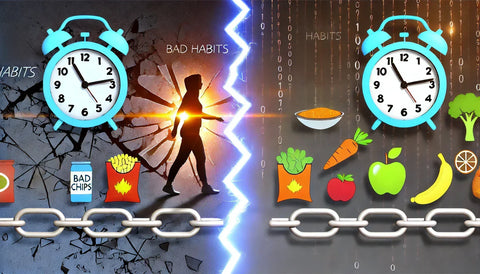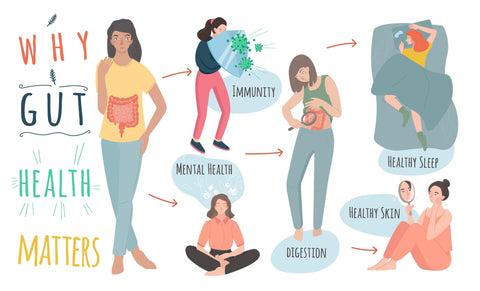We all have habits that we wish we could change—whether it's skipping workouts, procrastinating on important tasks, or reaching for unhealthy snacks when we're stressed. At the same time, we often dream of building healthier habits, such as exercising regularly, eating more mindfully, or becoming more organized. But making these changes can feel daunting, especially when bad habits seem so ingrained.
The good news is that breaking bad habits and building new, healthy ones is entirely possible with the right approach. In this post, we’ll explore why habits form, how you can break the cycle of bad habits, and the strategies you can use to establish new, healthier patterns. With patience, persistence, and the right mindset, you can turn your goals into long-lasting, positive changes.
Understanding How Habits Work: The Habit Loop
To effectively change habits, it's essential to understand how they form. Habits are essentially behaviors we repeat regularly, often without thinking, because they've become automatic. According to Charles Duhigg, author of The Power of Habit, every habit follows a simple loop:
- Cue: A trigger that tells your brain to initiate the behavior (e.g., stress, time of day, location).
- Routine: The actual behavior or action (e.g., smoking, checking your phone, snacking).
- Reward: The positive reinforcement you get from completing the habit (e.g., stress relief, satisfaction, pleasure).
This loop is what keeps bad habits alive. The cue initiates the routine, and the reward makes you want to repeat the behavior. However, you can use this same loop to break bad habits and replace them with new ones by understanding your triggers and creating healthier alternatives.
When we think about habits, they can feel like an inseparable part of our daily lives. But once you break them down into the three-step process (cue, routine, reward), they become more manageable to understand and control. Often, people fail to break habits because they only focus on the routine (the action) without addressing the cue or the reward that follows. To be successful, you need to disrupt the entire habit loop.
Step 1: Identify Your Triggers and Cravings
Before you can change a bad habit, you need to identify what triggers it. Triggers can be external, like specific times of day, social situations, or even the environment around you. Internal triggers are equally powerful—they can be emotions, stress, boredom, or fatigue. By pinpointing your habit’s trigger, you can better understand why the habit exists in the first place and what you’re trying to satisfy.
Example 1: Emotional Eating
- Bad habit: Reaching for sugary snacks when you’re stressed or upset.
- Trigger: A stressful situation at work or an argument at home.
- Reward: The temporary comfort or distraction that the food provides.
Example 2: Procrastination
- Bad habit: Putting off work by scrolling through social media.
- Trigger: Feeling overwhelmed by a difficult task.
- Reward: Instant distraction and avoidance of the task’s discomfort.
Once you know your trigger, you can focus on either avoiding it or finding a healthier way to respond to it. It’s important to note that many bad habits are a way to cope with discomfort, boredom, or negative emotions. Understanding what you’re trying to avoid (or what you're seeking) is key to changing behavior.
Step 2: Replace Bad Habits with Healthier Alternatives
The best way to break a bad habit is not just to stop the behavior but to replace it with a new, healthier one. Your brain craves the reward it gets from completing the habit loop, so you need to provide an alternative routine that satisfies the same craving.
For example, if you’re someone who tends to snack when you’re bored, your trigger might be boredom and your reward is the feeling of satisfaction from eating. You can replace this routine with a healthier alternative—like drinking water, chewing gum, or taking a walk—while still addressing the craving for distraction or stimulation.
Here’s how you can apply this idea to common bad habits:
- Procrastination: Replace wasting time on social media with a 5-minute burst of productivity using the Pomodoro technique (25 minutes of focused work followed by a 5-minute break). The reward is not only getting started but also giving yourself permission to take breaks.
- Skipping workouts: If finding time or motivation is the issue, scale down the workout to something manageable. Instead of aiming for a 60-minute session, start with just 10 minutes of activity. The key is to build momentum. The reward could be a sense of accomplishment or a post-workout treat, like a smoothie or a relaxing stretch.
- Overspending: Replace impulsive purchases by giving yourself a "cooling-off" period before buying. Implement a 24-hour or 48-hour waiting rule before making non-essential purchases. During this time, you might find that the urge to buy fades. The reward can be financial peace of mind or saving up for something meaningful.
The idea here is to substitute your unhealthy routine with a new routine that still satisfies the craving but in a positive and healthier way.
Step 3: Start Small and Be Consistent
It’s easy to feel overwhelmed when trying to change multiple habits at once. Instead of overhauling your entire life, focus on making small, sustainable changes. This approach, often referred to as the "two-minute rule," involves starting with a habit that takes just two minutes or less. The idea is to make the habit so easy that it’s hard to say no.
For instance:
- Want to start reading more? Start by reading just one page per day.
- Want to exercise daily? Start with two minutes of stretching or a short walk.
The purpose of starting small is to reduce the resistance you may feel when adopting a new habit. Consistency is far more important than intensity in the beginning. You can always build on these small habits as they become ingrained. By making the new behavior effortless, you’ll find it easier to stick with it and build confidence in your ability to succeed.
Another powerful technique is to anchor new habits to existing ones, also known as "habit stacking." For example:
- After brushing your teeth (an established habit), do two minutes of meditation.
- After you make your morning coffee, take five minutes to stretch or write in a journal.
By linking your new habit to an existing one, you create a mental connection that makes it easier to remember and perform the new behavior.
Step 4: Use Positive Reinforcement to Strengthen New Habits
Our brains are wired to seek rewards, which is why we repeat habits that feel good. To build a new habit, it’s crucial to associate it with positive reinforcement. The reward doesn’t have to be big, but it should be something that makes you feel good or accomplished.
Here are a few ways to use positive reinforcement:
- Celebrate small wins: Acknowledge and reward yourself for even minor progress. This could be as simple as marking a habit streak on a calendar or giving yourself a mental "high-five." Small celebrations help reinforce the behavior and encourage you to continue.
- Visual reminders: Use visual tools like habit-tracking apps or a journal to mark each day you successfully perform your new habit. Seeing progress over time can be a powerful motivator, especially when you’re working toward long-term goals.
- Link new habits to positive emotions: Instead of focusing on the difficulty of change, focus on how great you’ll feel once the new habit is in place. For instance, if you’re building an exercise habit, remind yourself of the endorphin rush or the sense of accomplishment after each workout.
It’s important to remember that change is not just about discipline—it’s also about finding joy in the process. The more you can link your new habits to positive feelings, the more likely you are to stick with them.
Step 5: Be Patient and Forgive Setbacks
Building new habits takes time—research shows that it can take anywhere from 21 to 66 days to form a new habit, depending on its complexity. It’s crucial to stay patient and persistent, even if you slip up along the way. Remember, setbacks are part of the process, and it’s important not to let a single misstep derail your entire effort.
Tips for Managing Setbacks:
- Plan for challenges: Anticipate moments when you might struggle to maintain your new habit, such as during busy weeks or stressful situations. Have a backup plan in place (e.g., if you can't do your full workout, do a 10-minute session instead).
- Learn from mistakes: When you slip up, don’t dwell on the failure. Instead, analyze what happened. Did you fall back into your old habit because you were tired, stressed, or lacked a plan? Understanding why it happened can help you avoid repeating the same mistake.
- Reset and refocus: Missing one day doesn’t mean you’ve failed. In fact, research shows that occasional slips are normal and don’t significantly impact long-term success. What matters is getting back on track as soon as possible.
If you miss a day or fall back into an old habit, don’t give up. Recognize the slip-up, learn from it, and refocus on your goals. Consistency is key, but perfection isn’t necessary. Over time, your new habits will become second nature.
Step 6: Create Accountability
Accountability can be a powerful motivator when forming new habits. Whether you share your goals with friends, family, or a mentor, having someone who knows what you're working toward can help keep you on track. Partnering with someone who has similar goals or joining a community focused on habit-building can provide support, encouragement, and a sense of shared purpose.
Ways to Create Accountability:
- Find a habit partner: Team up with a friend who’s also trying to build healthy habits. You can check in with each other, share progress, and offer support on tough days.
- Join a group or community: Online communities or fitness groups can provide accountability through shared goals, friendly competition, or group challenges.
- Use technology: Habit-tracking apps like Streaks, or MyFitnessPal can help you stay accountable by logging your progress and setting reminders.
When you have someone to check in with or share your successes (and challenges), you’re more likely to stay committed to your new habits.
Conclusion
Breaking bad habits and building new, healthier ones is a gradual process, but with the right strategies, it’s completely achievable. By understanding the habit loop, identifying triggers, and replacing negative behaviors with positive alternatives, you can rewire your brain to support your goals. Remember to start small, celebrate your wins, and stay consistent, even when setbacks occur.
Healthy habits have the power to transform your life over time, leading to improved physical, mental, and emotional well-being. The journey may take time, but every step you take toward building better habits brings you closer to the version of yourself you aspire to be.
Now, what habit will you start working on today?



